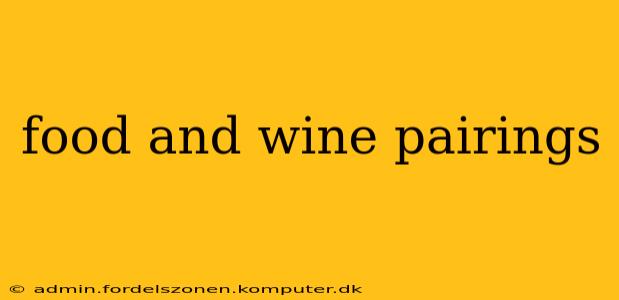Food and wine pairings: the seemingly simple act of choosing the right beverage to complement your meal can elevate a dining experience from pleasant to unforgettable. But navigating the world of wine and food can feel daunting. This guide delves into the fundamental principles, offering practical tips and examples to help you become a confident food and wine pairing expert.
What are the Basic Principles of Food and Wine Pairing?
The core principle revolves around balance and harmony. You want the wine and food to enhance each other, not clash. This involves considering several factors:
-
Weight and Body: Generally, lighter wines pair best with lighter dishes, and fuller-bodied wines complement richer foods. A delicate white wine would be overwhelmed by a heavily spiced stew, while a robust red would overpower a delicate salad.
-
Acidity and Fat: High acidity in wine cuts through richness and fat in food. This is why a crisp Sauvignon Blanc is a classic pairing with rich seafood or creamy pasta dishes.
-
Tannins and Protein: Tannins, the astringent compounds in red wine, pair well with proteins, particularly red meats. The tannins help cleanse the palate and prevent the richness of the meat from feeling overwhelming.
-
Sweetness and Spice: Sweet wines require careful consideration. They can pair well with spicy foods, as the sweetness balances the heat. However, avoid pairing overly sweet wines with sweet desserts—it can be too much sweetness.
-
Flavor Profiles: Look for complementary or contrasting flavors. For example, earthy mushrooms pair beautifully with earthy Pinot Noir. Conversely, a bright, citrusy white wine can cut through the richness of a creamy sauce.
What are the Best Food and Wine Pairings for Beginners?
For those just starting their food and wine pairing journey, here are some foolproof combinations:
- Chicken: Pinot Grigio or Chardonnay (oaked or unoaked, depending on the preparation)
- Salmon: Pinot Noir or a dry Rosé
- Pizza: Chianti or a light-bodied red like Dolcetto
- Steak: Cabernet Sauvignon or Merlot
- Pasta with Tomato Sauce: Sangiovese or a light-bodied red like Gamay
What Wine Pairs Best with Red Meat?
Red meat, with its richness and often intense flavors, benefits from the structure and tannins found in many red wines. Specifically:
- Beef: Cabernet Sauvignon, Merlot, Shiraz/Syrah, Malbec are all excellent choices. The specific cut of beef and preparation method will influence the best wine choice. A leaner cut might pair well with a lighter-bodied red, while a richer cut benefits from a fuller-bodied option.
- Lamb: Cabernet Sauvignon, Merlot, or a bolder Rioja can stand up to the robust flavors of lamb.
- Game: A powerful, age-worthy red like Barolo or Bordeaux is ideal for game meats like venison or duck.
What Wine Goes Well with White Meat?
White meats, often leaner than red meats, require a lighter wine to avoid overpowering their delicate flavors:
- Chicken: Pinot Grigio, Sauvignon Blanc, or Chardonnay (unoaked) are all versatile options.
- Pork: Pinot Grigio, Sauvignon Blanc, or a light-bodied red like Pinot Noir, depending on the preparation. A sweeter pork dish might benefit from a slightly off-dry Riesling.
- Turkey: Pinot Noir or a dry Rosé
What Wine Pairs Well with Seafood?
Seafood's delicate nature calls for wines with high acidity and refreshing qualities:
- Salmon: Pinot Grigio, Sauvignon Blanc, or a dry Rosé
- Tuna: Dry Rosé or a crisp white like Vermentino
- Shellfish: Albariño, Muscadet, or a light-bodied Chardonnay
What are some Popular Food and Wine Pairing Mistakes to Avoid?
- Overpowering the food: Choosing a wine that is too bold or tannic for a delicate dish.
- Clashing flavors: Pairing a wine with opposing flavor profiles (e.g., a very sweet wine with a savory dish).
- Ignoring acidity: Neglecting the role of acidity in balancing richness.
- Temperate Wine and Spicy Food: Pairing a full-bodied red wine with very spicy food could lead to a clashing experience. Consider a lighter red or even a rosé.
Conclusion: Embark on Your Food and Wine Pairing Adventure
Mastering the art of food and wine pairing is a journey of exploration and discovery. By understanding the fundamental principles and considering the various factors discussed above, you can confidently select wines that complement your meals and elevate your dining experience. Remember, experimentation is key. Don't be afraid to try new combinations and discover your own personal preferences. Happy pairing!
